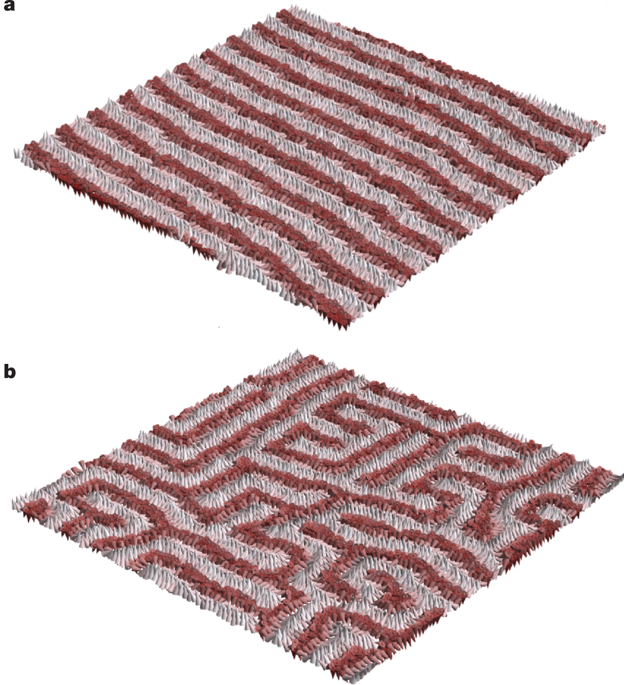Nature ( IF 50.5 ) Pub Date : 2020-01-01 , DOI: 10.1038/s41586-019-1845-4 Y Nahas 1 , S Prokhorenko 1 , J Fischer 2 , B Xu 3 , C Carrétéro 2 , S Prosandeev 1, 4 , M Bibes 2 , S Fusil 2, 5 , B Dkhil 6 , V Garcia 2 , L Bellaiche 1

|
Phase separation is a cooperative process, the kinetics of which underpin the orderly morphogenesis of domain patterns on mesoscopic scales1,2. Systems of highly degenerate frozen states may exhibit the rare and counterintuitive inverse-symmetry-breaking phenomenon3. Proposed a century ago4, inverse transitions have been found experimentally in disparate materials, ranging from polymeric and colloidal compounds to high-transition-temperature superconductors, proteins, ultrathin magnetic films, liquid crystals and metallic alloys5,6, with the notable exception of ferroelectric oxides, despite extensive theoretical and experimental work on the latter. Here we show that following a subcritical quench, the non-equilibrium self-assembly of ferroelectric domains in ultrathin films of Pb(Zr0.4Ti0.6)O3 results in a maze, or labyrinthine pattern, featuring meandering stripe domains. Furthermore, upon increasing the temperature, this highly degenerate labyrinthine phase undergoes an inverse transition whereby it transforms into the less-symmetric parallel-stripe domain structure, before the onset of paraelectricity at higher temperatures. We find that this phase sequence can be ascribed to an enhanced entropic contribution of domain walls, and that domain straightening and coarsening is predominantly driven by the relaxation and diffusion of topological defects. Computational modelling and experimental observation of the inverse dipolar transition in BiFeO3 suggest the universality of the phenomenon in ferroelectric oxides. The multitude of self-patterned states and the various topological defects that they embody may be used beyond current domain and domain-wall-based7 technologies by enabling fundamentally new design principles and topologically enhanced functionalities within ferroelectric films.
中文翻译:

铁电薄膜中迷宫畴图案的逆转变
相分离是一个协同过程,其动力学支持介观尺度1,2域模式的有序形态发生。高度退化冻结状态的系统可能会表现出罕见且违反直觉的逆对称破坏现象3。一个世纪前提出4,在不同的材料中通过实验发现了逆转变,从聚合物和胶体化合物到高转变温度的超导体、蛋白质、超薄磁膜、液晶和金属合金5,6,除了铁电氧化物,尽管对后者进行了大量的理论和实验工作。在这里,我们展示了在亚临界淬火后,Pb(Zr 0.4 Ti 0.6 )O 3超薄膜中铁电畴的非平衡自组装导致迷宫或迷宫图案,具有曲折的条纹域。此外,随着温度的升高,这种高度简并的迷宫相会发生逆转变,从而在更高温度下开始顺电之前转变为不太对称的平行条纹畴结构。我们发现这种相序可以归因于畴壁增强的熵贡献,并且畴的拉直和粗化主要是由拓扑缺陷的松弛和扩散驱动的。BiFeO 3中反偶极跃迁的计算建模和实验观察表明该现象在铁电氧化物中的普遍性。通过在铁电薄膜中实现全新的设计原则和拓扑增强的功能,大量的自图案化状态和它们所体现的各种拓扑缺陷可以用于当前域和基于域壁的7技术之外。











































 京公网安备 11010802027423号
京公网安备 11010802027423号